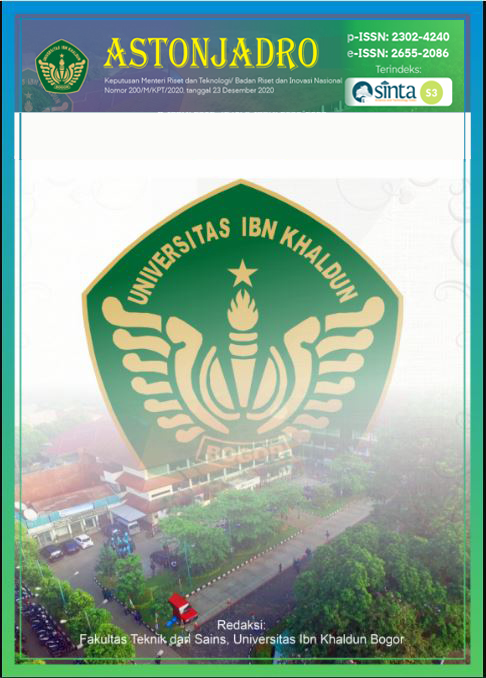Influence Substitution of Tabas Stone Waste which Coated Polyester Resin to Concrete Compressive Strength
DOI:
https://doi.org/10.32832/astonjadro.v12i3.9065Keywords:
tabas stone waste, coarse aggregate, water absorption, polyester resin, compressive strength of concrete.Abstract
The need for the use of concrete raw materials is increasing in line with the increase in the use of concrete in construction. The availability of concrete raw materials is dominated by the exploitation of natural resources, namely components of cement, sand and crushed stone or gravel. If the availability of this material is exploited in excess, it will have an impact on environmental damage. On the other hand, many stone crafts for decoration and building ornaments in Bali also utilize tabas stone which is also exploited from nature, where the processed rock leaves a lot of waste that is disposed of without any wise processing actions. Tabas stone waste management is expected to maximize the utilization of natural resources and also reduce environmental pollution caused by the disposal of tabas stone waste that is not managed properly. This research is expected to provide an alternative to maximize the use of tabas waste as a partial substitution of crushed stone or gravel as coarse aggregate in concrete mixtures. The porous structure of tabas stone and the high level of water absorption in the concrete mix can reduce the compressive strength of the concrete. Steps to reduce water absorption in tabas stone are carried out by maximally closing the pores using a polyester resin coating. The study was carried out by making normal concrete mixture objects according to SNI 03-2834-2000. The percentage of substitution of crushed stone with waste stone that is coated with polyester resin is 0%, 25%, 50%, 75%, 100% of the required weight of coarse aggregate. The compressive strength of the concrete will be tested at the age of 7 and 28 days using a cylindrical specimen measuring 150x300mm. Test results in the laboratory showed that the coating of tabas stone using polyester resin was able to reduce the level of water absorption from 9.96% to 3.24% or 67.5% compared to tabas stone that was not coated with polyester resin. The optimum compressive strength of coarse aggregate substitution using tabas was obtained at variations of 50% crushed stone 50% tabas stone at the age of 7 days and 28 days, respectively, reaching 15.06 MPa and 21.55 MPa.References
ACI committee 318. (2011). Building Code Requirements for Structural Concrete and Commentary (ACI 318M-11). In American Concrete Institute, Farmington Hills, MI.
Badan Standardisasi Nasional. (2000). Tata Cara Pembuatan Rencana Campuran Beton Normal. SNI 03-2834-2000. Badan Standardisasi Nasional, 1–34.
Batubara, P., Irawan, R. R., Hardono, S., & Budiman, Y. I. (2015). Beton dengan Sedikit Semen Portland dan Tanpa Semen Portland dengan Memanfaatkan Abu Terbang PLTU Batubara.
Desai, D. (2011). Development Of Light Weight Concrete. February 2019, 1–15. http://www.engineeringcivil.com/development-of-light-weight-concrete.html
Ellis, L. D., Badel, A. F., Chiang, M. L., Park, R. J.-Y., & Chiang, Y.-M. (2019). Toward electrochemical synthesis of cement—An electrolyzer-based process for decarbonating CaCO 3 while producing useful gas streams . Proceedings of the National Academy of Sciences, 201821673. https://doi.org/10.1073/pnas.1821673116
Intara, I. W., Alit K. Salain, I. M., & Anom Wiryasa, N. M. (2013). Penggunaan Serbuk Batu Tabas Sebagai Pengganti Sebagian Semen Dalam Pembuatan Beton. Jurnal Spektran, 1(1), 1–7. https://doi.org/10.24843/spektran.2013.v01.i01.p01
Karthika, R. B., Vidyapriya, V., Nandhini Sri, K. V., Merlin Grace Beaula, K., Harini, R., & Sriram, M. (2020). Experimental study on lightweight concrete using pumice aggregate. Materials Today: Proceedings, 43(April), 1606–1613. https://doi.org/10.1016/j.matpr.2020.09.762
Kurniawan, A. T., Dewi, S. M., & ... (2016). Pengaruh Penambahan Cat Pada Agregat Kasar Batu Pumice Terhadap Kekakuan Balok Beton Bertulang Dua Tumpuan. … Jurusan Teknik Sipil. http://sipil.studentjournal.ub.ac.id/index.php/jmts/article/view/295
Mukesh Dattaram Ghadge, & Vaibhav Dhondiram Kamble. (2015). Floating Concrete by using Light Weight Aggregates and Air Entraining Agent. International Journal of Engineering Research And, V4(08), 99–104. https://doi.org/10.17577/ijertv4is080338
Saini, R. K., Godara, A., Maheswari, A., & Kumar, M. A. (2018). Experimental Study on Light Weight Concrete with Pumice Stone as a Partial Replacement of Coarse Aggregate. Universal Review, 7(V), 48–55.
Salain, I. M. A. K., Ciawi, Y., Nadiasa, M., & Sutapa, A. A. G. (2019). Performance of Black Stone Waste as Coarse Aggregate in Concrete Production. International Journal of Engineering and Technology, 11(1), 1–5. https://doi.org/10.21817/ijet/2019/v11i1/191101002
Salain, I. M. A. K., Wirasa, M. N. A., & Pamungkas, I. N. M. M. A. (2020). Kuat Tekan Beton Geopolimer Menggunakan Abu Terbang. Jurnal Spektan, 8(1), 105–114.
Sangeetha, S. P., Divahar, R., Mawlong, K., Lyngkhoi, B., & Kurkalang, A. (2020). Mechanical characteristics of pumice stone as light weight aggregate in concrete. International Journal of Scientific and Technology Research, 9(1), 3760–3762.
SNI 03-2847. (2013). Persyaratan beton struktural untuk bangunan gedung. In Bandung: Badan Standardisasi Indonesia.
Sunaryo, G. (2007). Rancangan Campuran Batu Padas Buatan Jenis Kelating dengan Memanfaatkan Limbah Batu Tabas. Magister Teknik Sipil Universitas Udayana.
Triswandana, I. W. G. E., Aryastana, P., & Winata, C. (2021). The Utilization Of Black Stone Waste As An Alternative Material To Replace Partial Cement And Aggregate In Concrete. 8(12), 143–151.
Downloads
Published
How to Cite
Issue
Section
License
Copyright (c) 2023 ASTONJADRO

This work is licensed under a Creative Commons Attribution-ShareAlike 4.0 International License.
Paper submitted to ASTONJADRO is the sole property of the Astonjadro Journal. Unless the author withdraws the paper because he does not want to be published in this journal. The publication rights are in the journal Astonjadro.ASTONJADRO
LICENSE
This work is licensed under a Creative Commons Attribution-ShareAlike 4.0 International License.
Based on a work at http://ejournal.uika-bogor.ac.id/index.php/ASTONJADRO













